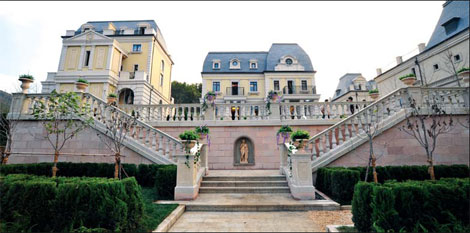Bordeaux looks to China amid slump
Updated: 2012-04-10 08:03
By Yang Cheng (China Daily)
|
|||||||||||
|
Chateaus in Bordeaux, the world's top wine-producing region, hope to attract more Chinese investors. |
French winemakers in Bordeaux, the world's top wine-producing region, are vying for more Chinese investors, said a senior official with the region's chamber of commerce.
"Their investment will create a win-win situation since many chateaus are currently experiencing sluggish business and an ever-shrinking market," said Pierre Goguet, president of the Chamber of Commerce and Industry of Bordeaux, during a promotional event for the China Dalian International Wine & Dine Festival, which is set to open on July 12.
A total of 10,000 chateaus have been built in the region, but even those that have been around for more than a century have been hit by market doldrums. But Goguet said he is optimistic about the investment outlook and noted the next decade will be "a decade for Bordeaux in the world's wine industry."
"More merger deals will mean better growth for those brands that boast quality and time-honored products," he said. Goguet plans to bring representatives of 90 enterprises from the region to China to meet investors.
Chinese winemakers have also launched a campaign to team up with world-class chateaus overseas.
A regional branch of Chinese investment firm CITIC broke ground last month on a wine production base in Shandong province in a joint venture with Domaines Barons de Rothschild, parent company of the Bordeaux region's renowned Chateau Lafite.
The initial investment in the base has hit 100 million yuan ($15.87 million). The company hopes to build on the momentum of its brand Lafite, which has been thriving in China. Within the country, the combined trading volume of faked and genuine Lafite is estimated to be between 2 million and 3 million bottles annually.
Last year, China's largest trader of grains and edible oils COFCO announced it had bought Chateau Viaud, a 20-hectare estate in Bordeaux, and expects it to yield 100 tons of wine every year.
The company's wine business is growing 15 percent every year, Wu Fei, COFCO wine president, said.
"This is only an element of our global roadmap, following our trail in Chile. More deals may happen in South Africa, the US, Australia and much more," an insider noted.
Dynamic approach
Discussing the company's foray overseas, wine expert Li Demei said that better operations and marketing for the wine products are vital to getting faster and sounder returns for the investors.
Japanese-based beverage producer Suntory bought Chateaus of Lagrange and Byechevelle in Bordeaux, and through better marketing channels it has made the two brands popular and cemented a foothold in Asia.
"Differentiated strategies for the operation and marketing of the products are key to future development," said Johnny Wang, vice-president of Haichang (Group) Co Ltd, which bought eight chateaus in the Bordeaux area, "each worth more than 10 million euros ($14 million)".
The private firm established a brand called La Mont in Bordeaux using the chateaus it bought.
In addition, Haichang has injected a total of 3 billion yuan to build a 333-hectare Dalian International Wine Industry Park in the Dalian Bonded Zone last December and considers wine culture, tourism and trade "three driving forces for growth".
Haichang will build Asia's largest wine museum to foster a more sophisticated local wine culture.
The city also plans to introduce some 1,000 varieties of wine to the park to trade under the bonded tax policy. The park will be open to tourists as well.
Currently, investors share the same dilemma when building their brands: faked foreign wines are still prevalent on the market, he said.
There are not as many genuine bottles of Lafite as there seems to be in China. Its combined production volume is only 200,000 bottles every year.
An empty 1982 Lafite bottle can be sold at 3,500 yuan in China, insiders say.
Statistics showed that China's retail wine sales hit 70 billion yuan last year.
Industry research firm Wine Intelligence indicated that the demand for wine among Chinese consumers will maintain an annual growth rate of 18.5 percent in the next few years.
Its counterpart IWSR noted China has become the second-largest brandy market in the world.
Consumer spending will surge by 47 percent from 2011 to 2015. By 2017, China will be the world's largest brandy market.
yangcheng@chinadaily.com.cn
Today's Top News
President Xi confident in recovery from quake
H7N9 update: 104 cases, 21 deaths
Telecom workers restore links
Coal mine blast kills 18 in Jilin
Intl scholarship puts China on the map
More bird flu patients discharged
Gold loses sheen, but still a safe bet
US 'turns blind eye to human rights'
Hot Topics
Lunar probe , China growth forecasts, Emission rules get tougher, China seen through 'colored lens', International board,
Editor's Picks

|

|

|

|

|

|






